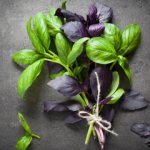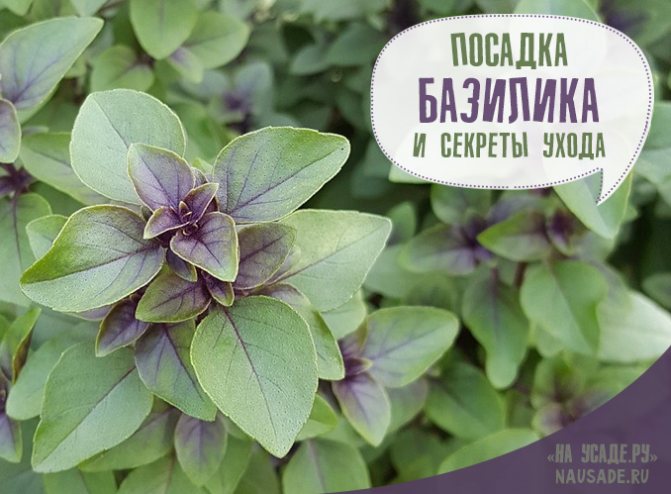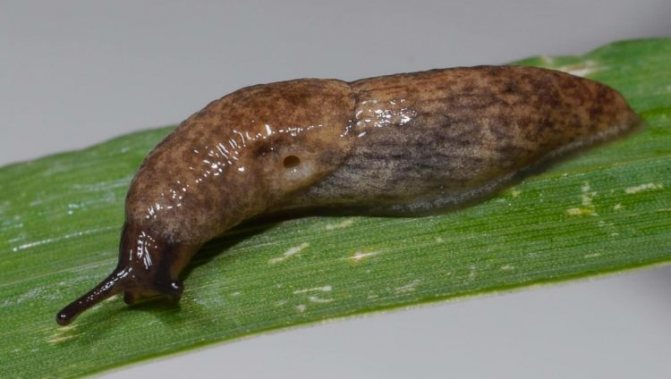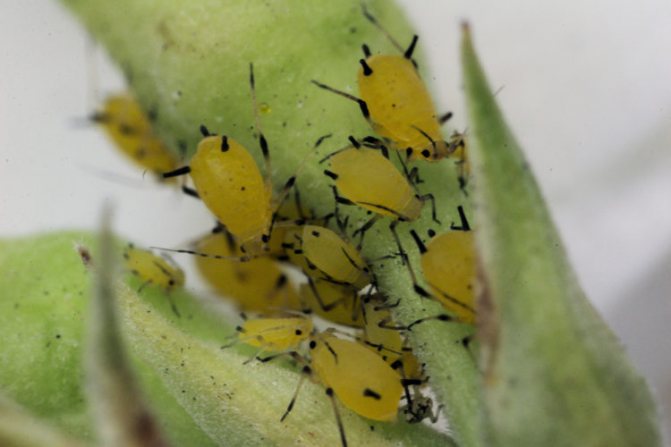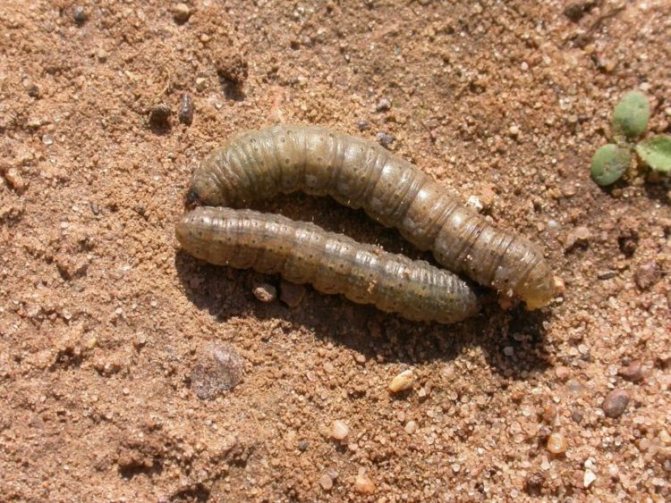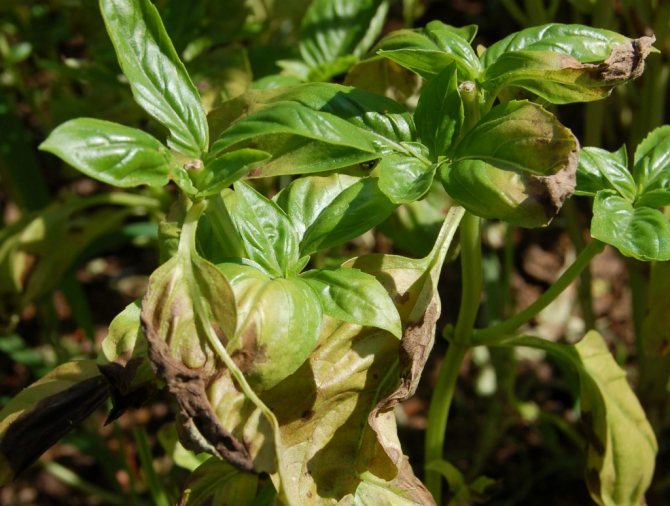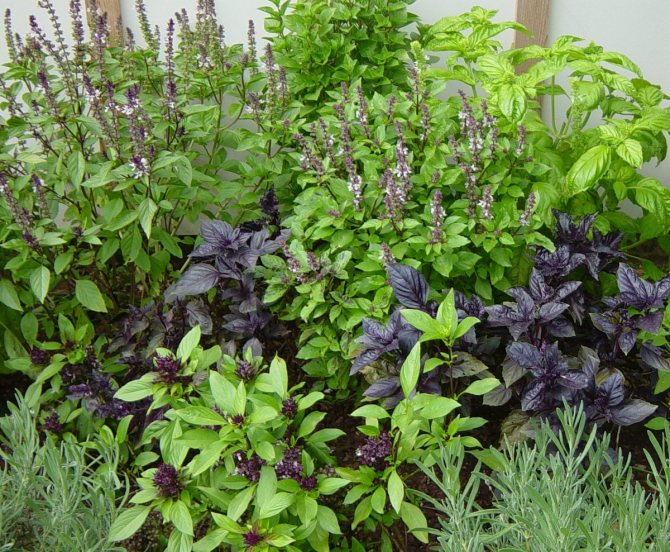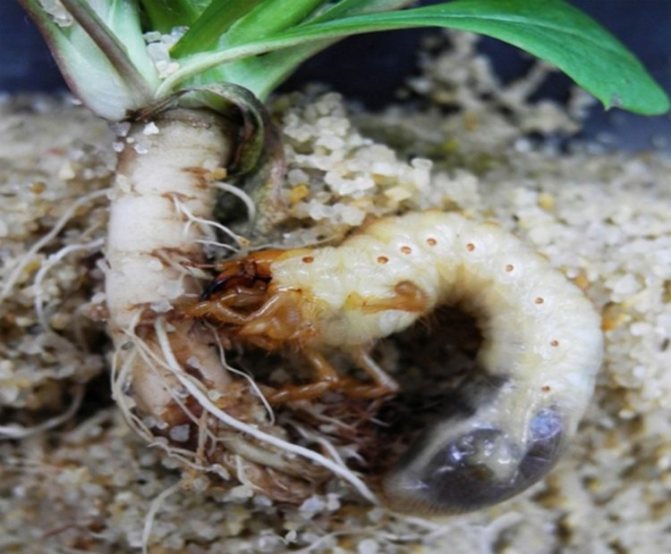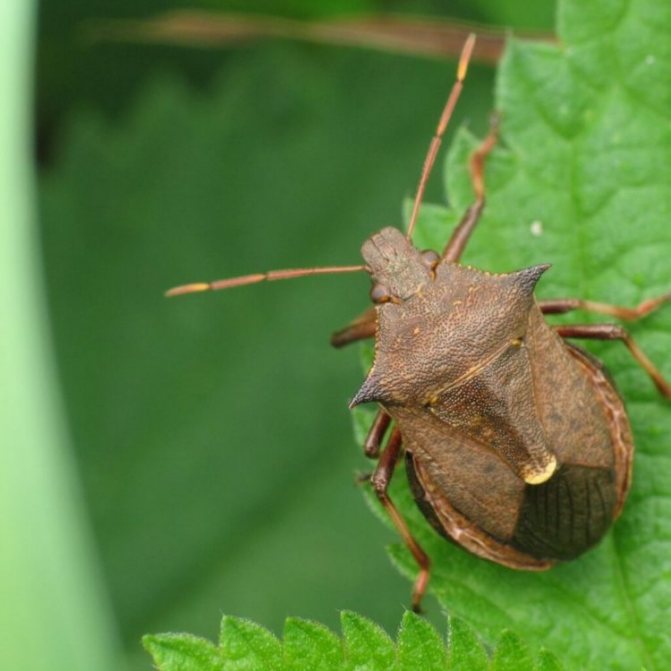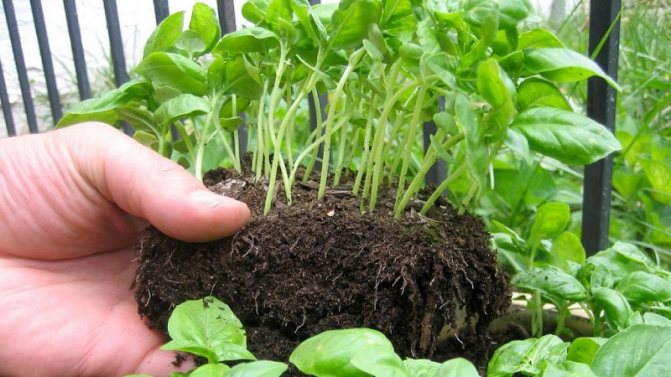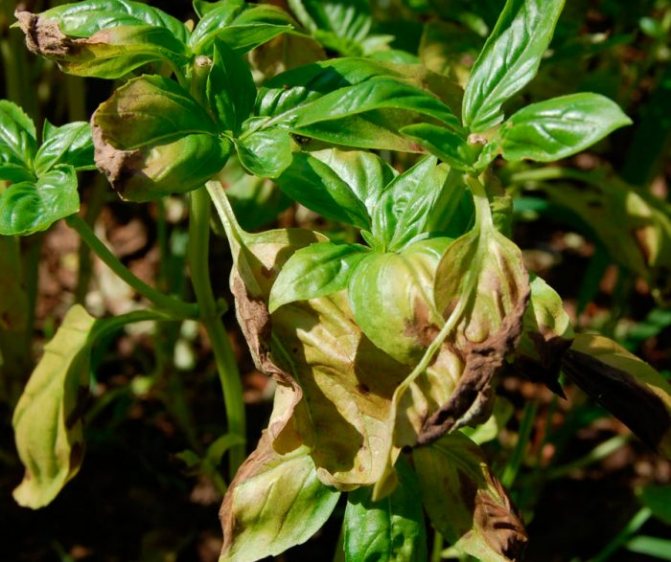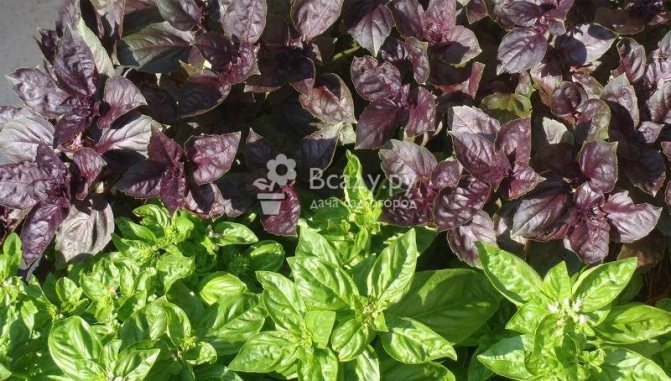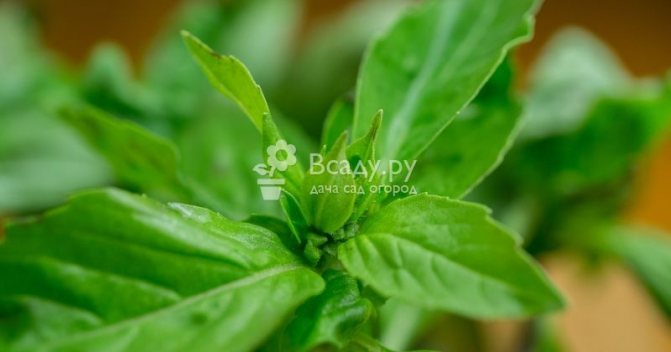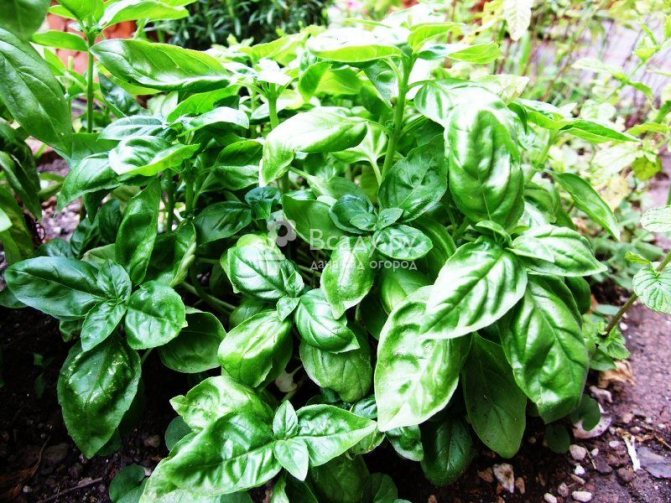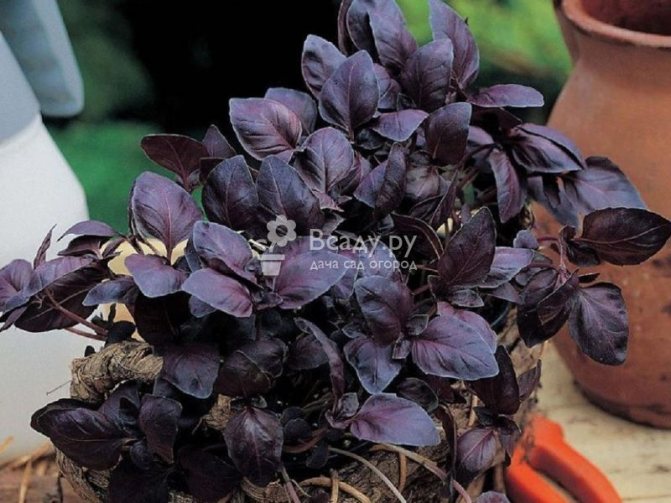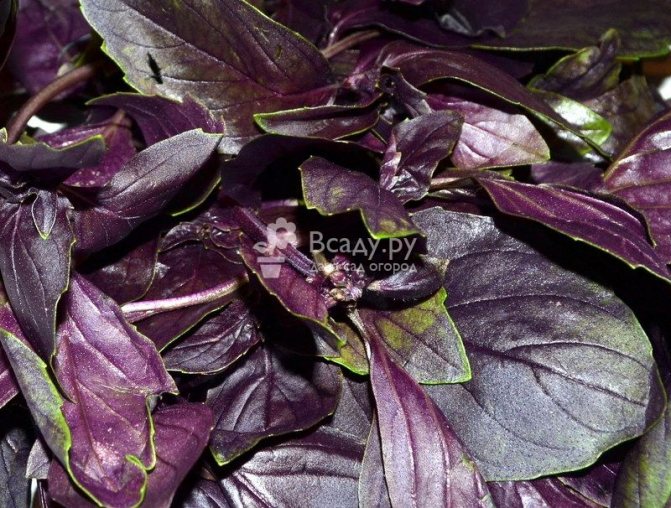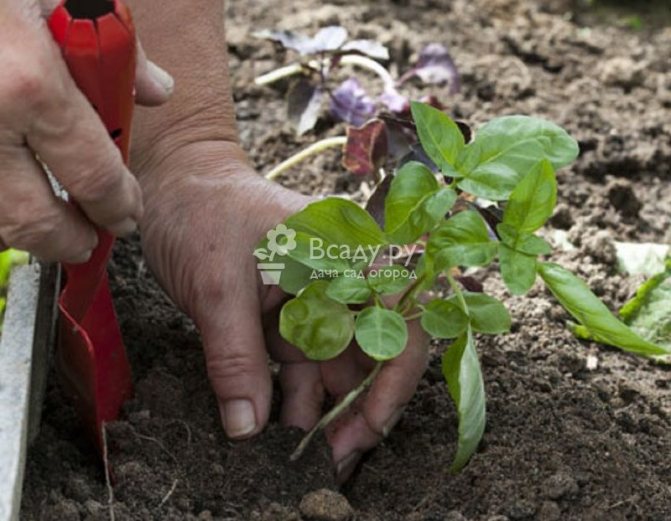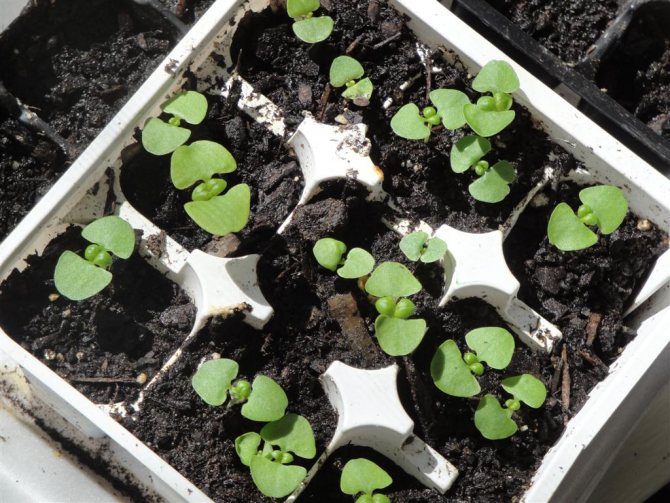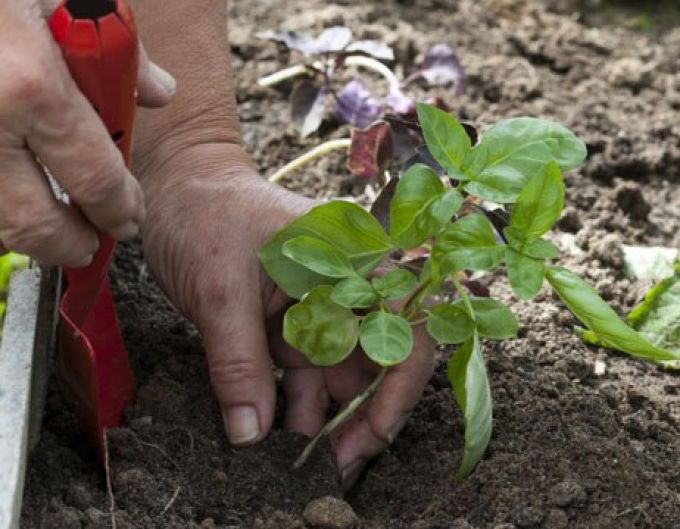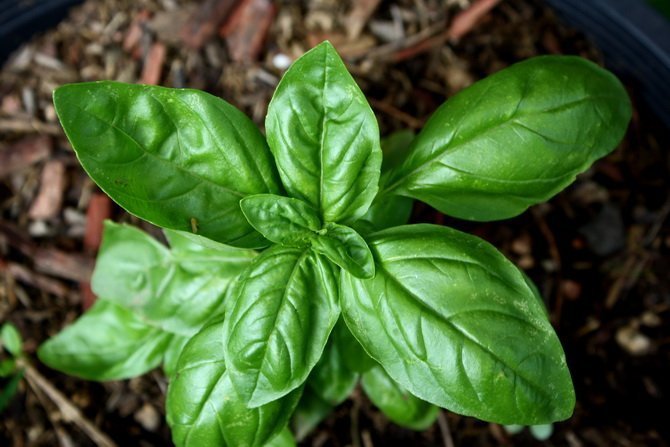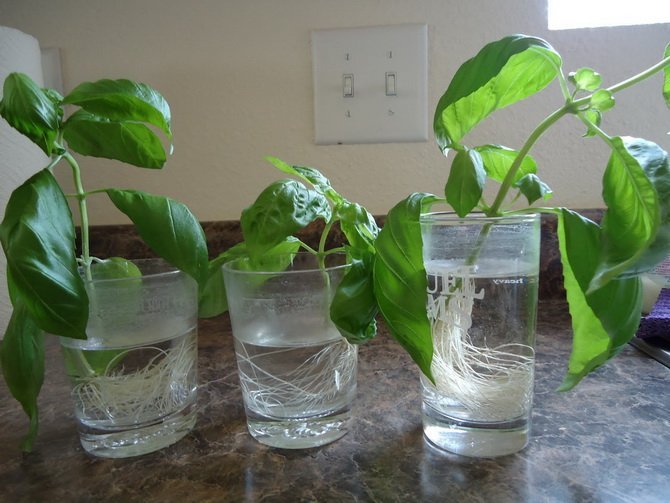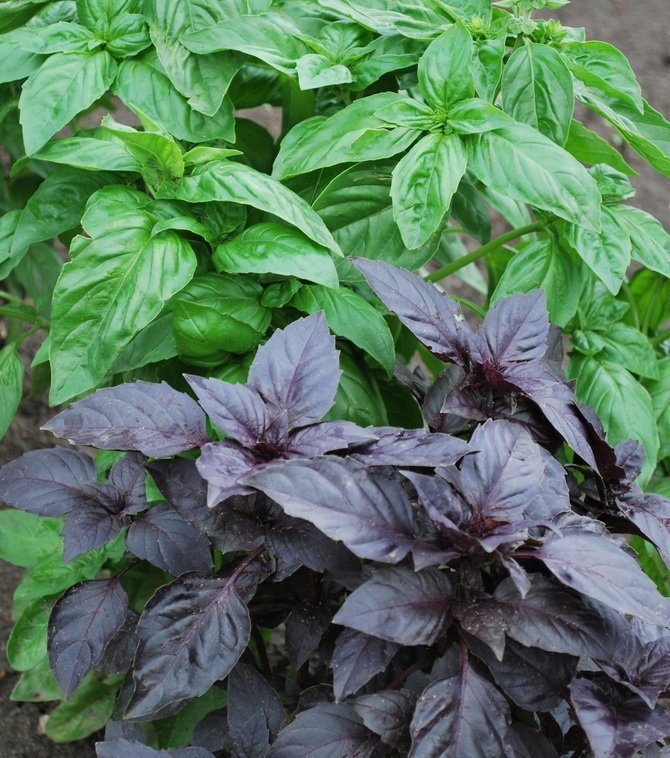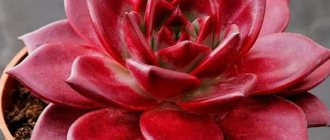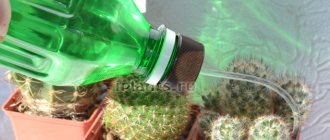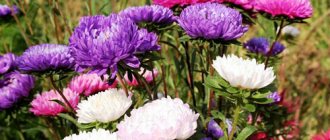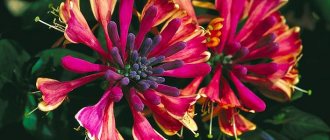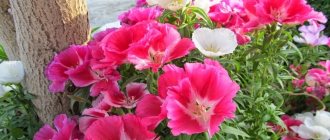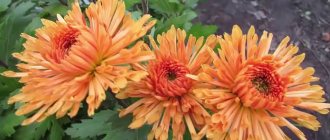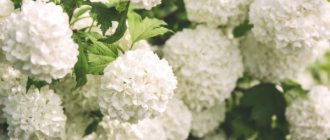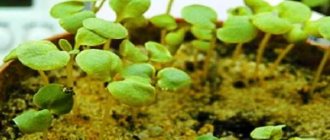Growing basil from seeds on your own makes sense if you plant a crop not only for your own consumption, but also for sale. The average family needs only a few bushes to provide themselves with fresh, dried spices and medicinal raw materials. They are easier to buy in the market.
But there they usually sell several varieties, and often the sellers themselves do not know which ones, but divide them by color: red and green basil. If gardeners or designers want to grow a specific or exotic variety, you will have to tinker with the seeds. There is nothing difficult in this, especially if there is a minimum skill of picking - you cannot do without it.
Preparing Basil Before Harvesting Seeds
The spice is grown for one purpose - to stock up on fragrant leaves that are used in cooking. If you plan to collect planting material, you will have to fulfill the requirements that allow you to get basil seeds, which will give friendly shoots.
The first raw material for use in cooking is cut off from the bushes only after the plant reaches two tens of centimeters in height. It is imperative to remove the leaves and the upper parts of the shoots, which will provoke the growth of lateral shoots.
It is not recommended to abuse it - after 2-3 harvests of leaves, allow the plant to gain strength, release powerful peduncles. Provide the bushes with full care - regular watering, loosening the soil. The basil will thank you for the care with large, high quality seeds.

After collecting the seeds, the taste of the leaves decreases - it is not recommended to use raw materials for cooking. In order not to be left without stocks of leaves, it is better to collect them in advance, freeze them (under the influence of low temperatures, the useful and taste qualities of greens do not decrease) or dry them and send them for storage in glass jars, plastic containers.
Basil diseases and pests
Basil does not belong to crops that often get sick, and pests generally prefer to bypass not only its bushes, but also those that just grow nearby. This is often used by advocates of organic farming to ease the fight against many crop-destroying insects.
If the basil grows freely, is watered moderately, it is unlikely to get sick. Thickened plantings and high humidity are more often a problem in greenhouses than in open field. But if the culture is planted without taking into account the growth of the bush, next to the plants requiring frequent watering, problems may arise. Basil will also suffer in too rainy summer, especially on dense soil. He can get sick:
- Fusarium. The stem will become thin, brown, then the top will dry out, the bush will gradually fade, despite watering and loosening the soil.
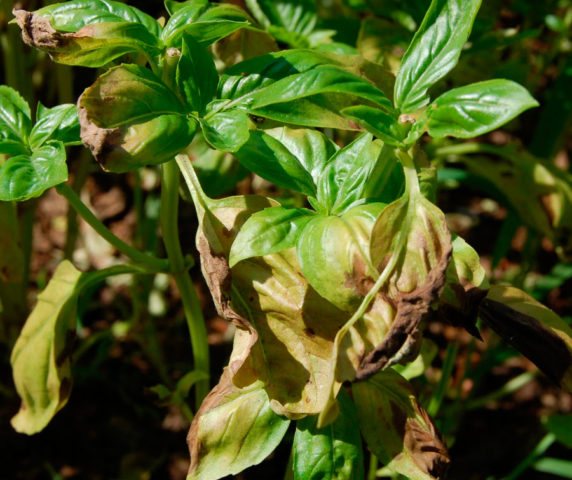

- Gray rot. This fungal disease begins to develop on the damaged parts of the plant. For example, if, when collecting leaves for salad or marinade, you do not carefully cut them off with scissors or pinch them off, but simply pull them, you can severely injure the plant. Gray rot manifests itself in the appearance of first white and then gray cannon on infected shoots.
In both cases, the diseased plant is simply destroyed, and as soon as possible.Preventive spraying of basil is not carried out, it is simply planted freely, it is not poured over, individual leaves and twigs are pinched off or trimmed neatly.


When to collect planting material?
There are no exact dates for collecting plant seeds - ripening depends on the implementation of the rules of care, climatic conditions, planting dates. Ripening of planting material occurs in the second half of July, but in early August it will be possible to stock up on products. Simultaneously with the appearance of testes, flowers bloom on the plants, which must be removed, stimulating the basil to give strength to the ripening of the planting material.
To determine the readiness of the inflorescences for collection, you need to carefully examine the testes. The signals to start the process are drying of the bracts and discoloration (they turn black).
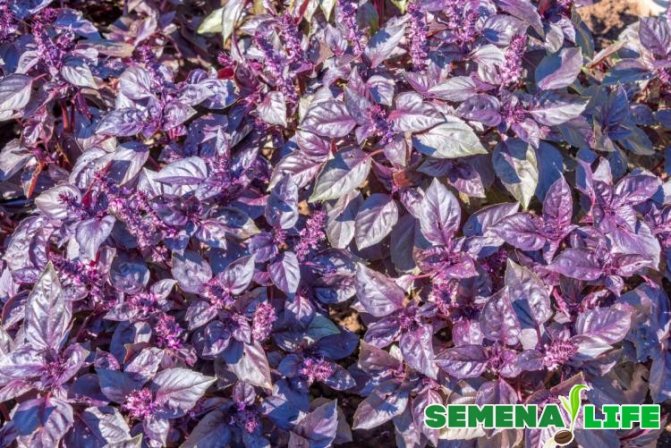

A prerequisite is to collect seeds in calm dry weather. High air humidity will affect the storage of planting material - even after prolonged drying, there is a risk of mold.
The difference between diseases and the attack of insects that eat leaves and drink juice
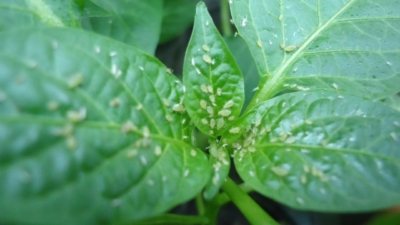

A plant disease is a violation of its functions in adverse environmental conditions or under the action of pathogenic pathogens. The latter include various types of molds, viral and bacterial infections. They affect the vascular system, due to which they gradually spread throughout the plant. Colonies of fungi grow and multiply due to the nutrients contained in the juice. As a result, basil dies due to lack of nutrition and moisture.
Unlike diseases, when attacked by pests, the plant is attacked by insects: larvae, aphids or slugs. Some of them eat basil juice, others eat the leaves. In the first case, the leaves of the plant dry up, in the second, holes are formed on the leaf plate. They are united by one thing - the process of photosynthesis is disrupted, because of which the plant stops producing the nutrients it needs and gradually withers.
How to collect basil seeds - step by step
In order not to be late with the deadlines, it is recommended to regularly inspect the basil bushes - the inflorescences will signal readiness for collection. No preliminary preparation is required - for the process you only need garden shears and mittens (for owners of delicate skin).
Step-by-step process for collecting seeds:
- Carefully examine the plant, identify large testes.
- Cut off the inflorescence with sharp scissors, be sure to capture part of the peduncle.
- Gently fold the inflorescences - they have to be tied into dense bunches.
It is not recommended to vigorously shake the collected testes - this will allow not to lose part of the planting material.
Benefits of basil
Essential oils in the ground part of the basil have a bactericidal, antioxidant, tonic effect, contains vitamins C, B2, PP, provitamin A, phytoncides, carotene, sugar, rutin.
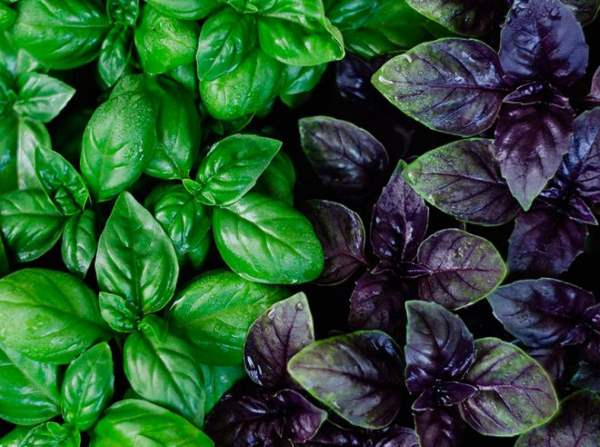

Basil is recommended for use in food for fungal infections, viral, bacterial diseases. It can easily cope with inflammatory processes in the oral cavity - unpleasant odor, plaque, ulcers, tartar, and strengthen the gums.
Dried basil is used to make tea, basil infusion relieves headaches.
Drying preparation
Drying is recommended before threshing the seeds, even if the seed plants are harvested in dry weather. Tie the collected raw materials into bundles of 6-8 inflorescences. For drying, choose a dry room, take care of ventilation.
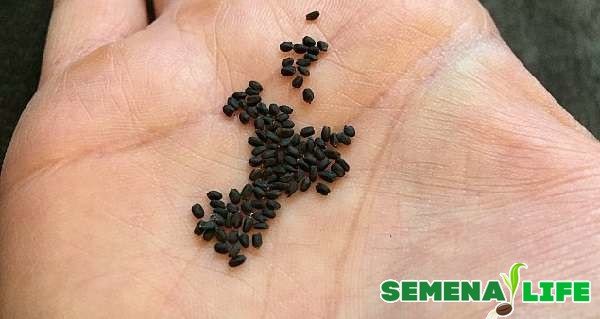

Stretch the twine under the ceiling, arrange the basil bundles. It is recommended to leave a space of 3-5 cm between them - each inflorescence should dry evenly.
If it is not possible to dry the plant raw materials in a suspended form, use baking sheets previously covered with thick cardboard, parchment, and newspapers.It is not necessary to knit the inflorescences in bunches - loose testes dry out better.
It will take two weeks to dry. During this time, stir up plant materials daily. Access to direct sunlight is undesirable - the seeds will dry out, and the similarity will decrease.
Harvesting
First you need to decide what to collect - greens for sale or freezing, or raw materials for drying. Young shoots 10-12 cm long can be cut up to 5 times per season. At the same time, the maximum yield of green mass per square meter of basil plantings is 1.5 kg. Pruning is carried out simultaneously for all the bushes as the branches grow. Then the plants are fed.


For subsequent drying, basil is harvested at the beginning of flowering, since then most of the essential oils are concentrated in the leaves. It is better to prune in the budding phase than to be late. Well-opened flowers pull off all the substances accumulated by the plant (essential, for example, to attract bees).
Basil is dried by tying the shoots in bunches and hanging in a dry, hot, well-ventilated room without direct sunlight. You can tear off the leaves and spread them out in a thin layer. But then you will often have to stir them up and turn them over. To preserve all essential oils, the drying temperature should not exceed 35 degrees.
Important! Basil leaves, when properly dried, retain their original color.


How to thresh basil, how to harvest seeds without loss?
Often, to separate the planting material from the testes, they simply do it - they rub the dried inflorescences with their hands. Doing so is not recommended - there is a risk of damaging the skin, provoking irritation. It is better to use dense linen bags, which will allow you to easily get the seeds.
Put the dried testes in a bag, tie tightly. Conduct threshing - gently tap on the surface with a stick or hand for 5-10 minutes.
Pour the contents of the bag onto a large mesh sieve. It is better to blow outdoors in windy weather. First, remove the particles of the testes with your hands. Wind carefully - the seeds are quite small.
Using a sieve to separate the planting material from the testes is another option for getting seeds. Be sure to make sure that the inflorescences are ripe and dry - this will facilitate the work. Stock up in advance with a pestle for grinding plant materials - it is not recommended to carry out the process with your hands, so as not to injure the skin.
With a pestle, gently rub the inflorescences in a sieve. Remove rubbish and testicles every 1-2 minutes. Complete the process with a breeze that will clear the planting material.
After threshing, it is recommended to re-dry the planting material in a room with low humidity and high temperature. Use baking sheets or thick cardboard sheets. 2-3 days are enough for drying. It is imperative to stir up the seeds; if damaged grains are found, remove immediately.
What do parasites look like, and also how to treat gnawed plants?
Aphid
The aphid is a small insect with an elliptical translucent body 0.3 to 0.8 mm long. The pests are covered with soft chitin. The color of the aphid matches the shade of the affected leaves, there are light green, dark, gray individuals. Long antennae and red eyes are located on the trapezoidal head of insects.
You need to get rid of aphids as quickly as possible, because the colony multiplies quickly and can destroy young plants. In addition, after the pest, its waste products remain on the surface of the leaves - sugary secretions, on which soot fungus grows well. Because of it, in addition to aphids, a dark bloom appears on the surface of the leaves.
Aphids drink plant sap by attaching themselves to vessels. As a result, the growth of the spice slows down, the basil becomes sluggish. The leaves turn yellow, wither and fall off. To combat the pest, the following means are effective:
- Folk. Decoctions based on odorous plants, the juice of which repels insects. These types include:
- bitter pepper;
sagebrush;
- dandelion;
- tansy;
- garlic;
- tomato and onion.
- Chemical and biological products. These include:
- Karbofos.
Bankcol.
- Akarin.
- 1% Actellic solution.
The tops or husks of plants are placed in water, the volume of which should be 4 times the amount of ingredients taken, and boiled after the liquid boils for 3-4 minutes. The resulting solution is cooled and filtered, after which the plant is sprayed with it.
Also, a soap solution is effective against aphids, with which the leaves are wiped: 100 ml of liquid tar soap is dissolved in 1 liter of water. Processing is carried out 2-3 times with an interval of 1-1.5 weeks in the open field.
Funds are prepared strictly in accordance with the attached instructions. Otherwise, a person may become poisoned, and the basil dies.
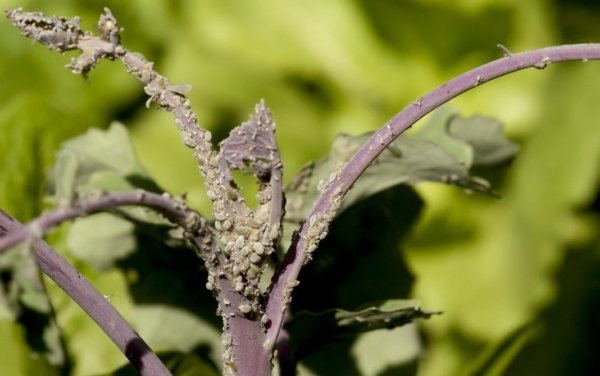

Spider mite
They are small bugs with a rounded body that eat the roots and leaves of the basil. When they appear on the plant, a spider web appears. You can get rid of insects with the help of a soap solution and decoctions based on protective plants:
- tomatoes;
- potatoes;
- wormwood;
- calendars.


Snails
A swirling shell is located on the body of the snails. The body of a gastropod mollusk consists of a head and a leg, covered with a mantle. On the head of the snails there are 2 tentacles with eyes. They eat basil leaves and multiply around plants by laying eggs in the topsoil.
To get rid of the clutches, the earth is loosened. The eggs themselves die in the open air. Slaked lime and salt are effective against snails, which are sprinkled on plants and soil. ammonia solution. A vial of ammonia is diluted in 10 liters of water and poured with a solution of basil.
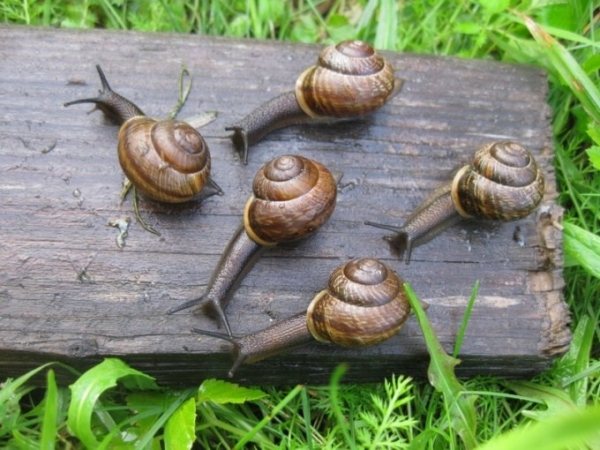

Slugs
Slugs are gastropods with an underdeveloped or completely absent shell. They reproduce by laying eggs in the upper layers of the soil. They prefer alkaline soils rich in potassium.
After hatching, they move to the leaves of nearby plants and eat them. As a result, many holes appear on the leaf plate that can be discerned with the naked eye. Slugs can be collected by hand, eggs and young individuals living in the ground are killed by loosening the soil. You can sprinkle plants and soil with slaked lime, which decomposes the internal organs and outer shell of pests.
Attention!
Natural enemies of slugs and snails are toads and hedgehogs. Therefore, you should not rush to drive them out of the garden if some plants eat pests.
You can get acquainted with the pest in the photo:
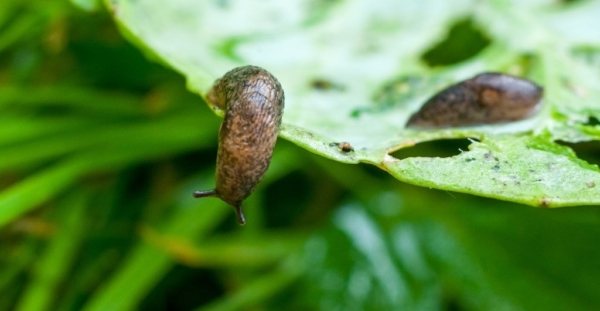

Bug
Field bugs have a rounded body covered with rigid chitinous growths and are strong with an exoskeleton. Pests are colored dark brown, black and light beige. Bed bugs feed on plant sap, so they stick to the vessels on the leaves of the basil.
You can suspect an attack by a field bug on seedlings by changing the appearance of the leaves. In this case, the leaf plate is deformed, the growth of the plant slows down, and white spots appear on the surface of the leaves that remain after insect bites. After defeat, the leaves die off.
Effective against the field bug:
- Preparation of a soap solution. 100 g of tar soap is rubbed and diluted in 1 liter of warm water, after which it is sprayed with a solution of the plant and the leaves are wiped.
- The use of chemicals: Actellik, Banol, Karbofos.
- Sprinkle the leaves with wood ash or prepare a solution from it. 300 g of powder is diluted in hot water, which is boiled for 30 minutes before preparing the product. After the resulting mixture has cooled, it is diluted with 10 l of water. The resulting composition is sprayed or watered with basil in a row.
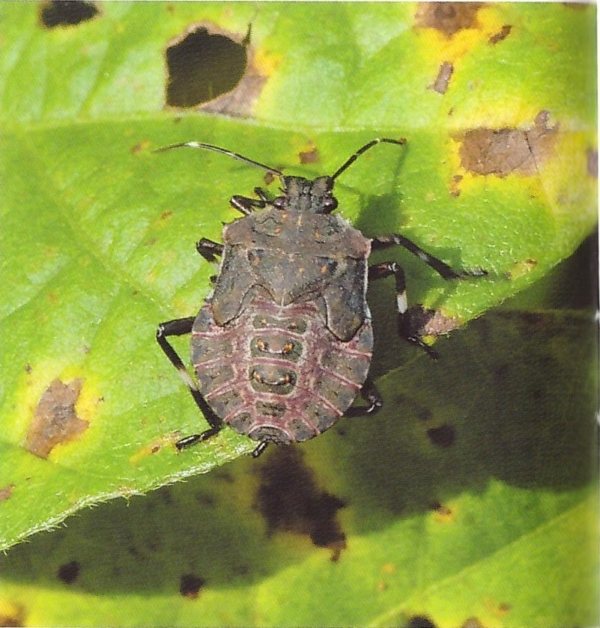

Khrushchi
Khrushchev are small beetles with an oblong body surface 4 to 60 mm long.Adults are covered with hairs and scales. Black, brown, red and light yellow insects are distinguished by color.
Unlike other types of pests the beetles eat the basil root system at a depth of 15 cm. They are the beetle larvae, which are often confused with the bronzers. The most effective way to control pests is deep digging of the earth and mechanical destruction of insects.


Caterpillars
Basil is attacked by the caterpillars of the winter moth, which eat the leaves. They have an oblong fleshy body of gray-brown color. Holes remain on the leaves. Caterpillars usually crawl out at sunset, and during the day they sleep on the underside of the leaves. Spraying basil with infusion of wormwood, tomatoes, potatoes is effective against them.
To prepare the product, you need to take 300 g of tops, boil in 1.5 liters of boiling water for 3 minutes. After that, the solution is filtered and diluted with 9 liters of cool water after it has cooled down.
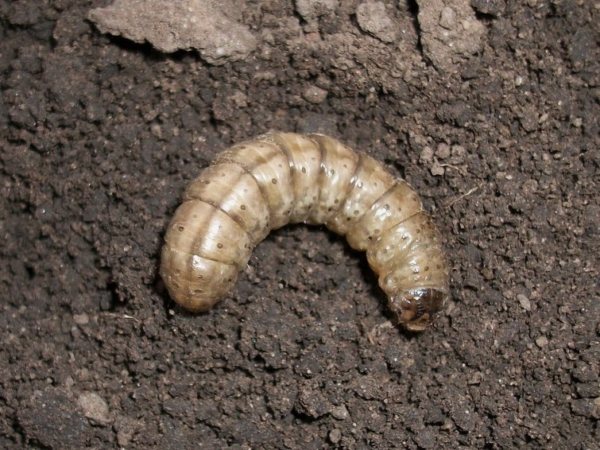

How to store basil seeds properly
Compliance with the rules for storing planting material affects the similarity, therefore it is recommended not to make mistakes that threaten to damage the seeds. There are several options that will help protect plant materials from rotting or drying out.
For storing planting material, boxes made of cardboard or thick paper are chosen. Canvas bags are another option to protect raw materials from damage. It is not recommended to use plastic containers with tight-fitting lids or polyethylene bags - without fresh air, the seeds will begin to rot.
During storage, it is recommended to regularly check the planting material. If the seeds are damp, sprinkle on a sheet of paper, dry away from sources of heat and direct sunlight.
Is there a difference between green and purple lesions?
Purple and green basil are attacked by the same pests and diseases. But the first type of spice is more resistant to the development of fungal and viral diseases. The growth of a colony of pathogenic microorganisms is suppressed due to the inclusion of antacids and a large amount of organic acids in the violet basil. In addition, this type of plant accumulates toxic mercury faster. Therefore, it is considered resistant to various types of diseases.
Important!
Usually, fungal and viral infections only affect the purple cultivar when it is weakened. This happens with improper care, damage to the root system during transplantation, and attack by pests.
Insects are discouraged by the pungent smell of purple basil. The green variety gives off a mild aroma and is not able to withstand pests. Purple basil has a high concentration of essential oils, due to which it tastes pungent and bitter and gives off a pronounced spicy aroma.
Preparing basil seeds for planting
Having saved the basil without loss until spring, the last process will remain - a similarity check. If storage errors are not made, each grain will give a full-fledged sprout. To make sure of the quality of self-collected raw materials, you need to sow in January-February. The soil to choose for growing seedlings is light, rich in nutrients. Be sure to count the grains - this will allow you to easily determine the similarity. Usually up to 20 seeds are planted.
A greenhouse made of polyethylene, a piece of glass, with which to cover the container, will help to speed up the appearance of sprouts. Place the container on a windowsill that is abundant in warmth and light, after having moistened the surface of the substrate abundantly. The sprouts will appear in a week. Throwing out the plants after checking the similarity is not necessary - after 3-4 weeks, pick into separate cups to get early seedlings.
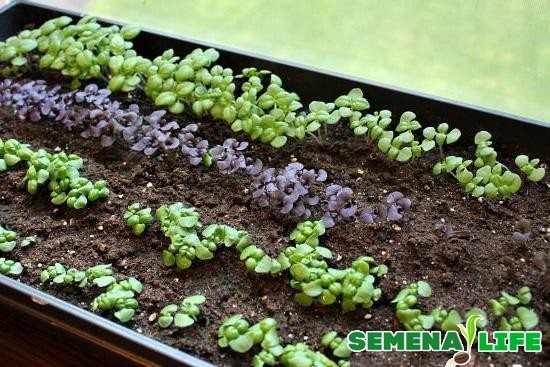

Even good similarity does not guarantee that all seeds are of proper quality. It is recommended to remove low-quality material before planting. To do this, pour the grains with warm water, leave for a quarter of an hour.Good seeds sink to the bottom, overdried, moldy ones float on the surface of the water. It remains to drain the liquid along with the floating grains to get the raw material ready for planting. Before sending to the ground, dry the basil for 1-2 hours.
To get quality basil seeds, you don't have to go overboard or research the many requirements. The process is no different from collecting seed from other vegetables or herbs. The main thing is to complete the processes without making mistakes that will affect the storage and similarity of the seeds. The results of a job done correctly are lush bushes of your favorite spice.
Description and features of the basilica
Basil is a genus of shrubs and herbaceous plants, consisting of 69 species, with an annual or long-term life cycle from the Lamiaceae family. The appearance and height differ depending on the belonging to a particular taxon. In culture, the most common varieties of the Basilica:
- fragrant (it is called ordinary, garden);
- mint-leaved (camphor);
- eugenol;
- thin-colored (tulasi).
Comment! To date, enough varieties have been bred from these species to satisfy most of the gastronomic preferences of gourmets and the aesthetic requirements of designers.


Garden and ornamental varieties of basil grow up to 20-80 cm in the form of a branchy bush with superficial roots. Leaves can be large or small, smooth, corrugated, covered with hairs. Their color varies from salad to dark purple, the smell is anise, lemon, mint, clove, clove-pepper. Small flowers are collected in 6-10 pieces. in loose brushes.
To date, the question of how to distinguish perennial basil from an annual one is not for domestic gardeners and gardeners even in the most southern regions. The culture is so thermophilic that at temperatures below 12-15⁰ C it stops the growing season. Where summer temperatures rarely exceed 20 degrees, cultivating basil outdoors does not make sense.
Growing from seeds in the open field
Spicy herb is one of the plants that need sun and warmth. By creating optimal conditions for development, you can get a good harvest.
You can plant basil in the garden, in the country.
Also, some gardeners dig up a perennial spice and transfer it to the house. There they grow basil in pots or other containers.
You can plant a spice directly in open ground or get it by sowing seedlings.


When basil is sown, the planting process
The seedling method is considered the most successful and simplest, therefore it is used much more often.
The optimal time to start sowing is the end of March. If for some reason it was not possible to have time to sow basil for seedlings, you can still have time before April 10-14.
In order to sow basil, you need:
- Prepare containers. These can be plastic cups, boxes, pots and any other container.
- Pour nutrient mixture into the container.
- Next, make grooves to a depth of about 1 cm.
- Pour gently with settled water at room temperature.
- Arrange the basil seeds in the grooves.
- Sprinkle a little earth on top. The main thing is that the top layer does not exceed 1 cm. Otherwise, it will be difficult for the sprouts to make their way out.
- Cover containers with foil, put in a shaded and warm place.
When shoots appear, you need to thin them out. For this, the seedlings are examined and the strongest and healthiest are left. The rest are removed.
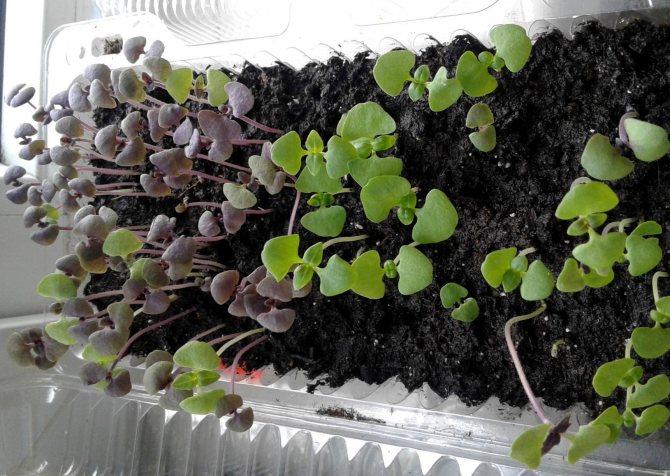

How to care for seedlings
When growing seedlings, it is important to monitor the condition of the soil. This should be done daily. Excessive waterlogging of the soil mixture should not be allowed.
Excess moisture leads to a disease called Black Leg. It can completely destroy the seedlings.
Also, you shouldn't leave the ground too dry.Seedlings that are not yet strong can dry out quickly from lack of moisture.
Seed soaking
A novice vegetable grower is perplexed when he sees wetted seeds - they are covered with mucus.


This happens very quickly with fresh seeds and slightly slower with older seeds. This process is normal, but creates difficulties for sowing.
Basil seeds can be soaked in the event that you intend to water the soil before sowing and then keep it moist.
You can not sow the soaked seed in dry soil - it will die.
The photo shows how the seeds spread out on a damp cloth became covered with mucus. Hydrophilic polysaccharides (mucus) act as a protector. They stretch moisture and protect the seed from drying out and hypothermia. If you keep them in a warm place (wrapped in a plastic bag) for 12-15 hours, then seedlings will appear 7-9 days after sowing.
Possible problems
There are a number of problems with growing basil. The main difficulties include the following:
- The seed coat does not fall off the seedlings. There may be several reasons: too deep sowing of seeds, very loose soil, during the passage of which the shell did not meet resistance and did not fall off. It is impossible to remove the shells with your hands in any case, you risk damaging the sprouts and being left without a crop. Better to wet the shells every 4-5 hours, they will swell and fall off.
- For a long time there are no shoots. This problem can arise due to deep planting, but there is a possibility that the seeds were expired or not germinating.
- Lodging of sprouts. There are two reasons for this: insufficient watering or a black leg disease.
- Slow growth after a pick. The reason may lie in uncombined ground. To correct the problem, water thoroughly and gently compact the soil.
- Change in leaf color. As a rule, it signals a lack of nutrients.
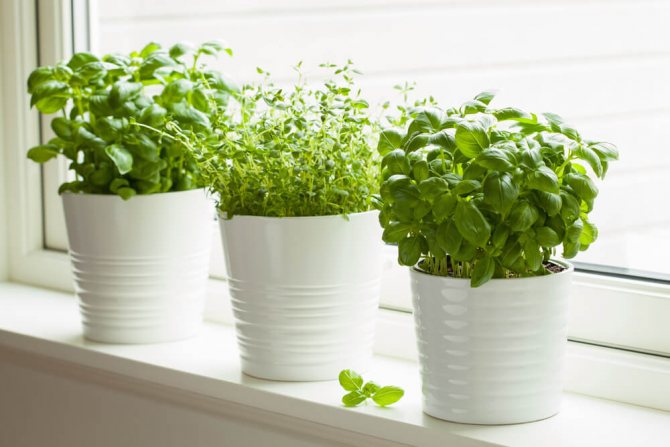

What is a basil plant
This plant, originally from Asia, has several varieties, varieties differ in color, shape of leaves. The cuisine of European countries widely uses green basil for cooking.
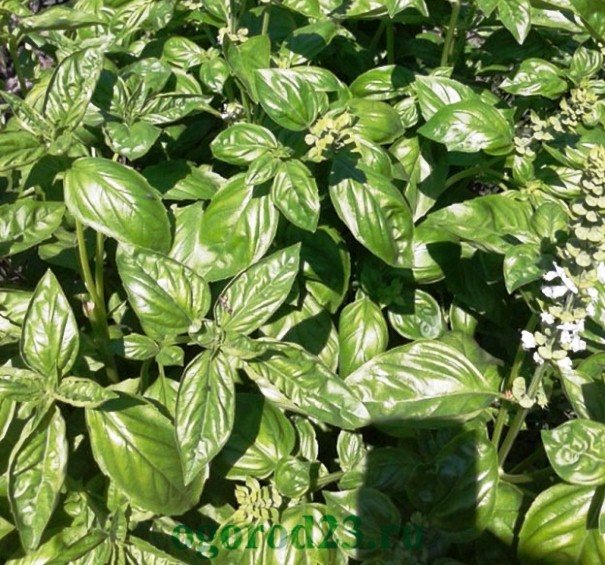

Green basil
In our country, on the contrary, its violet counterpart is more common, which has a bright, pronounced aroma.
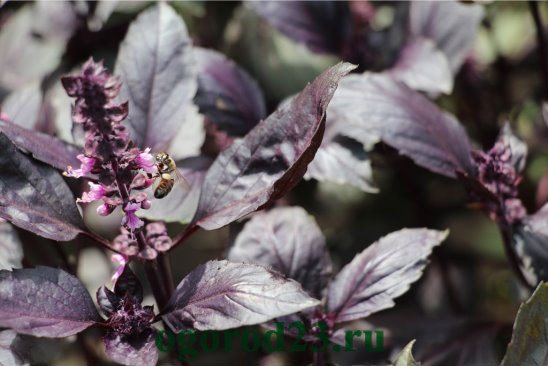

Purple basil
The leaves of the Baku variety are purple in color, their smell is somewhat reminiscent of a mixture of mint, clove (seasoning) aromas. Basil with a bluish color (Yerevan) smells like tea, allspice. Green Basil (Spoon-shaped) - smells a bit like laurel with an admixture of cloves.
In addition to its culinary purpose, this aromatic culture has a fairly wide application, since its leaves and stems contain many vitamins, essential constituents, camphor, carotene, potassium. Purple basil has bactericidal, antioxidant, anti-inflammatory properties. Its use has a positive effect on the nervous, genitourinary system. An interesting fact is that mosquitoes, midges, flies do not like the smell of basil, so it will be advisable to sow it near gazebos, benches or other recreational areas in your country house.
Dry or fresh basil leaf is used to prepare a wide variety of dishes, sauces, soups. It should be added very carefully, as it can completely change, even interrupt, the taste of the main ingredients.
Varieties to choose from
Among the whole variety of varieties, there are several proven ones that are guaranteed to delight you with their taste.
Basil Yerevan - has leaves of a rich bluish color, has a persistent pleasant aroma of tea and allspice.
Basil Spoon-shaped - it has already light green leaves and an aroma that resembles both cloves and bay leaves.
Basil Baku - the color of the leaves is purple-brown, and the aroma has a mixture of mint and clove odors.
Fragrant Basil - aka Camphor - is widespread in the beds of the whole world and is well known to every spice lover.It reaches a height of 50 cm and has a pronounced clove aroma.
Basil Magical Michael - known for its good tillering ability.
Basil Mammoth - grows large leaves and has a fairly pungent taste.
Cinnamon basil - aka Mexican - already from the name it is clear that it has a cinnamon flavor. It grows up to half a meter in height and blooms with purple flowers.
Basil purple - got its name from the red-purple color of the leaves. Its leaves are large, fleshy and delicate in taste. It enjoys well-deserved popularity in the Caucasus, where it is called "regan".
Lemon basil - and this name is quite eloquent - the aroma and taste of its leaves are lemon. Add to this its incredibly lush leaf mass - up to 250g of greens can be harvested from one bush.
Photo gallery of basil varieties
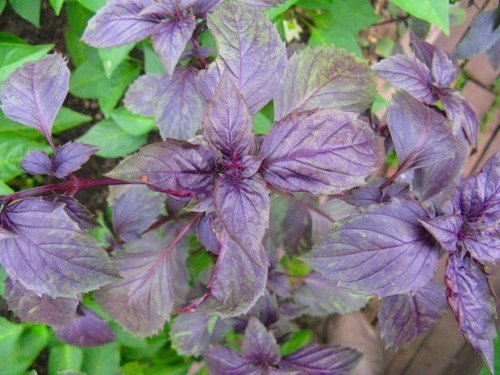

Basil Yerevan
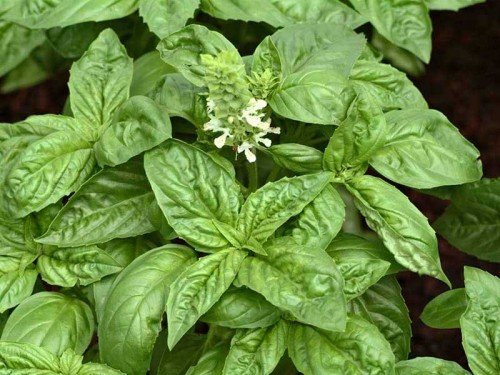

Sweet Basil or Camphor
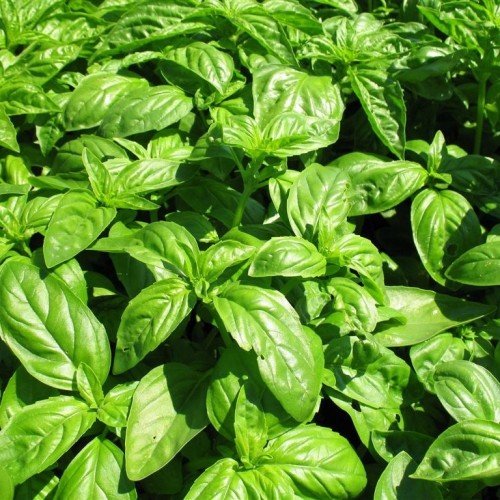

Basil Magical Michael
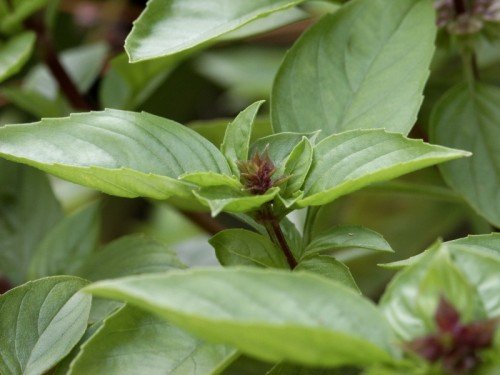

Basil Mammoth


Basil Cinnamon
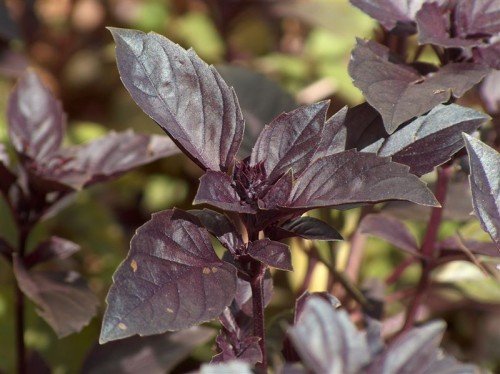

Basalik Violet aka Regan
Growing basil is a rewarding activity, because as a result you get an excellent seasoning that makes the taste of many dishes much richer. There is a wide variety of varieties to choose from, from which you can choose the one that suits your taste and aroma.
Storing basil leaves
It should be noted that the basil plant grows in man-made conditions all year round, and at any time you can buy a fresh, just cut basil sprig with fragrant foliage, in markets or in supermarkets. But many people prefer to make preparations for the winter of the grown basil herb in their personal plot. There are two storage methods for this.
- Freezing. The plucked basil leaves are sorted out, they are not beautiful, damaged, dried up or rotten. Selected juicy and beautiful leaves are washed under running water, and then laid out on a rack covered with cardboard. Such a rack is usually installed outdoors, in a shaded area. Or you can dry it indoors, on a regular table, covered with material or paper. The washed leaves are laid out in a thin layer and covered with thin paper or a piece of material to avoid insect and dust settling. Leaves are dried in this way, for several hours, quite often stirring them together. This is done so that the lower leaves also dry out evenly and not mold. Many gardeners chop the leaves with a knife before drying, motivating the convenience of use. This is permissible and does not affect the retention of essential oils in the leaves. After all the moisture has evaporated from the leaves, they are carefully folded into special bags, tightly wrapped and sent to the freezer. The disadvantages of this method are that the thawed leaves must be used immediately, otherwise they quickly wither and lose their original color and aroma. More qualitative in this matter, after all, drying.
- Drying basil leaves. Leaves are prepared for drying in the same way as for freezing, only they are kept on a rack until completely dry, constantly turning the plants over. The dried leaves are carefully placed in paper bags or cloth bags. Store in a dry, cool and dark place. Before using the ready-made seasoning from basil leaves, you need to gently rub the dried leaves with your fingers, for convenience and a pleasant appearance of the prepared dish.
Using the above tips and tricks, you can successfully grow beautiful, spicy basil herb in your backyard, greenhouse or windowsill.
Breeding with seedlings
It is very difficult to achieve friendly shoots and a large yield from small seeds, but a plant that is healthy and grown on a windowsill gives much more chances. That is why seedlings are so popular in open field cultivation. Let's say you already have it purchased or obtained as a result of growing your own seeds.Let's take a closer look at what to do next.
- We loosen the ground in the garden. The fraction should be the same as when sowing corn. It is advisable to use rollers so that the soil is compacted and the roots can easily absorb water from the soil and the basil is fully developed.
- We dig holes 10x10x20 centimeters, where the last indicator is depth. We pour 5 grams of nitrate at the bottom, a little soil on top, place the plant and fill it with water so that everything dissolves well, and the root system immediately receives a large amount of fertilizer.
- We mulch the earth from above with humus so that it does not crack. This is desirable for beds that are simply in the shade and required for areas in the open sun. It is best to avoid direct rays - there may be plant burns and growth retardation, best of all spices grow under 30% shade.
The subsequent care of the seedlings is very simple. 1 foliar top dressing with urea or diluted nitrate every 2 weeks. Pinching is necessary after the fifth pair of leaves is formed on the plant. You can mow seedlings after 3 weeks - at the discretion of gardeners.
Full Attention: Let's Start With the Soil
Basil requires complete attention in caring for itself. Yes, it is quite resistant to disease and does not attract pests very much. But at the same time he is very picky about the composition and quality of the soil and heat. However, this does not mean that during its cultivation it will take an incredible amount of time and effort to succeed.
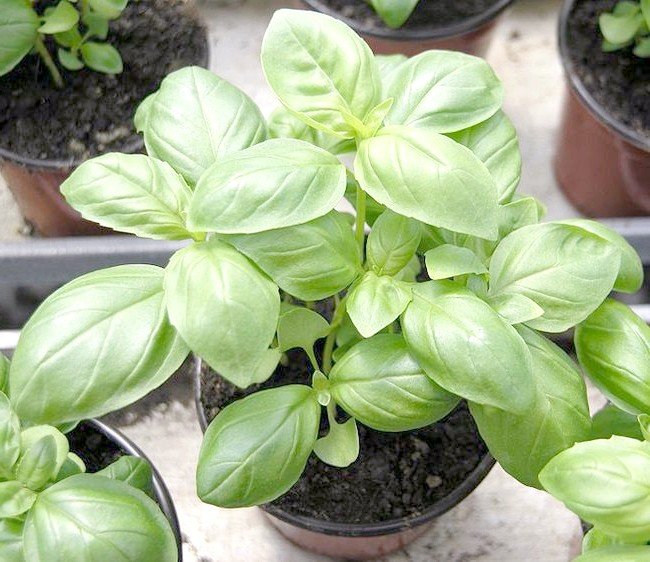

Basil is a plant that is demanding on soil and heat. But the effort put into growing it is worth it.
First, let's talk about soil. For the successful cultivation of basil, it must be well processed and fertile. Considering that such land is far from always available, efforts will have to be made. Basil loves to settle in warm, heated areas, while closed from winds and drafts. Light sandy loam in combination with organic matter introduced into it is the best soil option for basil. It is even better if potatoes, cucumbers, tomatoes or legumes grew in this place before it. These crops require a stable introduction of organic matter, and this is only a plus for our culture.
Soil preparation begins in the fall, when the earth is dug 20-25 cm deep, and 3-5 kg of compost or humus are added per square meter in combination with 25 g of superphosphate and 15 g of potassium salt.
If you are going to grow basil on heavy loamy and clayey soils, it is recommended to form ridges in the fall, and in the spring to process them with a hoe to a depth of 15 cm.
Frequently asked questions
Why doesn't basil spring up?
There may be several reasons for this:
Reason 1... Bad substandard seeds. Before planting, be sure to check the seeds for germination: sow a few things in the ground and wait for the shoots, or soak in a wet cloth and wait for the shoots.
Reason 2... It's cold in your apartment (or garden). Or the drawers are on a cold windowsill. That is, the earth is not warmed up enough. Sowing seeds should be done only in warm ground!
Reason 3... Perhaps the seeds will still sprout, they just sprout for a long time, as they are covered with essential oil.
Reason 4... You have sown them very deeply. And if, moreover, your soil is heavy or it rained heavily, then a crust formed, and the plants simply could not break through it.
Why is it growing poorly?
Most likely, you are not following agricultural practices. Perhaps he is cold or dark. Or you rarely water it. It may be that you planted the plant in a draft - and he categorically does not like this.
Maybe you have acidic soil - it needs to be calcified. He also does not like heavy clay soils, as well as excessively flooded with water.
Or perhaps it lacks nutrients - the soil is very poor. In this case, carry out feeding.
Is it possible to bury basil seedlings?
Experts advise against doing this.Basil is not a tomato; it does not like grooves until the first leaves. It is advisable to deepen it quite a bit when unpacking.
Then plant basil, the best predecessors?
In general, basil is a very friendly plant and has good compatibility. You can plant it after any culture. But it will be better if you choose an area after legumes, cucumbers and potatoes. Just remember that you cannot grow this plant in one place every year.
IMPORTANT! * when copying article materials, be sure to indicate an active link to the source:
If you liked the article - like it and leave your comment below. Your opinion is important to us!
Seed quality
Basil seeds quickly lose their germination. When buying, pay attention to the packing date - it must be no later than last year.
The manufacturer offers varieties:
- green and purple;
- cinnamon;
- lemon;
- clove basil.
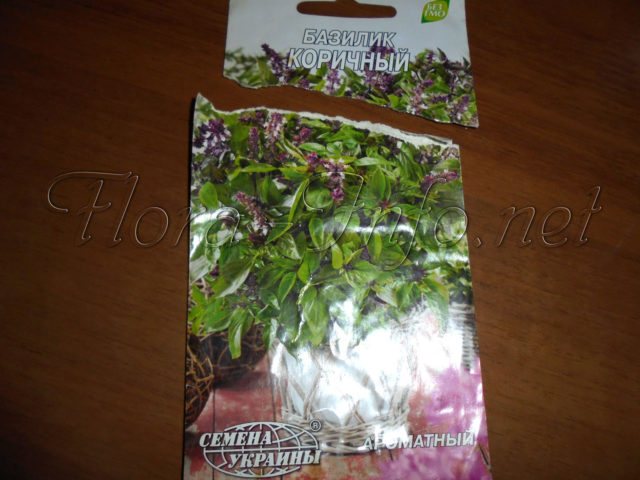

Having bought all sorts of different ones, it is not a fact that you will be satisfied with everyone. Something will be chosen, and something will disappear forever. However, you will recognize different smells and different taste sensations.
If you manage to find indoor basil seeds, don't pass by. Its seeds are slightly smaller, and the bush looks like a tree. The leaf is small and very fragrant. Such a plant:
- decorate the kitchen;
- will create a fragrant atmosphere;
- will add flavor to your culinary delights.
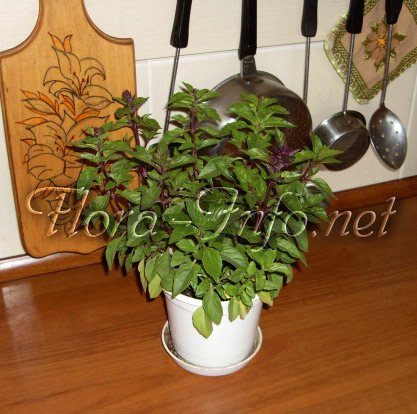

Having grown indoor basil as in the photo, you can easily cut it.
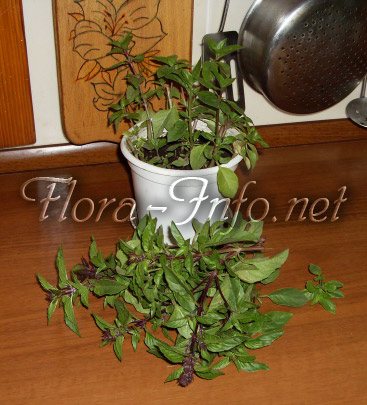

After a while, the bush will grow again and will be even more magnificent.
Aromatic, multifaceted - well-known basil
“… The flowing face is closed by a wall of rotating spokes. The one who never sleeps does not need basil. »Basil is a beautiful plant, an excellent healer and a favorite spice, the secrets of cultivation of which I will tell you in this article.
Basil is a beautiful plant, an excellent healer and a favorite spice.
A native of Asia, basil did not immediately conquer Europe, despite the fact that it was worshiped in Iran, India and Ceylon. By the way, the Indians believed that basil leaves were a kind of pass to heaven for the deceased. This plant was also adored in Greece - translated from Greek, basil means "royal". But in Europe for a long time they treated him like a cursed plant. In the Middle Ages, Europeans sincerely believed that the smell of basil magically affects a person and turns him into a scorpion.
Several centuries passed before basil was appreciated in Europe: first it began to be grown in Italy, where the fame of a symbol of family well-being and fertility was entrenched, then in France, where basil became a favorite spice.
What is the best - cut or pull out by the roots?


In order for basil to delight you with its harvest several times in one summer season, cut off the leaves of this spicy herb, do not uproot it... If you pull out the bushes by the roots, then you can already forget about re-harvesting.
It is not necessary to cut off the entire bush completely, but part of the leaves, leaving 3-4 leaves on the main stem of the plant.
It is the partial cutting of the leaves, and not completely of the entire bush, which will allow to build up an even richer leaf mass. If the bush is cut off completely, then the re-harvest will have to wait much longer.
Neighborhood with other plants


Basil is not such a capricious plant as, for example, fennel. It's very friendly.
Next to what to plant basil in the garden? The first one he is friends with is a tomato. The thing is that these two plants need the same growing conditions, and the agricultural techniques are very similar. Growing it together with tomatoes will save the latter from voracious caterpillars - tomato lovers. Some gardeners even believe that basil enhances the taste of tomatoes.
Also, this culture can be planted next to peppers and any legumes. The latter will well enrich the earth with nitrogen, from which the basil will grow especially lush.Zucchini, pumpkins and eggplants will not be upset from such a neighborhood.
You can plant basil next to lettuce or cabbage lettuce. Purple varieties will look especially beautiful in these plantings. Onions, cucumbers and kohlrabi are other great neighbors for this plant. Dill, marjoram and white cabbage cannot coexist with basil. They will grow poorly together, and you are unlikely to see a good harvest.
Preventive measures
Sure, it is impossible to protect the garden from diseases and pests, but you can try to minimize losses:
- Treat the soil with ash from deciduous trees once a week.
- Loosen the soil.
- Dig deeply before planting every year.
- Provide oxygen to plants.
- Water in moderation.
- Remove affected plants in a timely manner.
In the article, we tried to collect the most important and useful materials about diseases and pests of basil, as well as methods of prevention and treatment. We hope that the reader has found the necessary information and that his basil will grow healthy and tasty!
If you find an error, please select a piece of text and press Ctrl + Enter.
Reproduction methods
Basil can be propagated in two ways - by cuttings and by seeds.
Cutting is the propagation of plants by parts of the plant itself. You just need to cut a sprig of basil, put it in water and after 8-14 days it will take root. After that, the twig is transplanted into a pot. The first greens that can be eaten will appear in a month.
The second method is more time consuming, but thanks to it you will get a much larger bush and a larger yield. This method involves the propagation of basil seeds. Seeds can be bought at the store or collected from a bush you have on the site.

